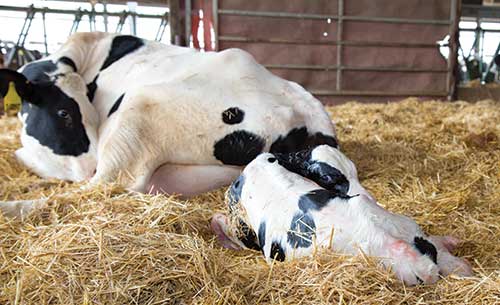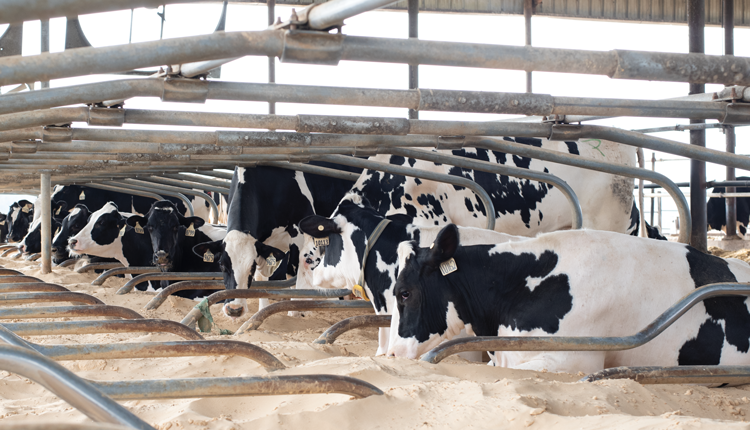The authors are with National Animal Health Monitoring System (NAHMS) and the Integrated Livestock Management Program, Colorado State University, Fort Collins, Colo.

Do you know how many calves you lost as a result of dystocia last year? Could some of those calves have been saved? Between 30 and 50 percent of all calvings require assistance, and approximately 1 out of 10 of these calves die at the time of birth due to dystocia or complications from a difficult calving. Calves that survive dystocia are still at greater risk of experiencing disease and death before weaning.
The most dramatic physiological changes in life occur during birth, and failure to adjust after birth frequently leads to death. There are three relatively simple practices that can be implemented to reduce losses from dystocia.
1. Stimulate respiration.
2. Maintain body temperature.
3. Expand blood volume by feeding colostrum.
A breath of fresh air
Calves are born with low levels of oxygen and high levels of carbon dioxide in their blood. Even a normal delivery results in a phenomenon called "birth asphyxia," which occurs when the blood supply from the umbilicus is cut off but the calf is not yet breathing.
After delivery, the calf must begin breathing by inflating the lungs and initiating gas exchange to raise the level of blood oxygen and lower the level of carbon dioxide. High blood levels of carbon dioxide result in respiratory acidosis and play a critical role in stimulating respiration.
During dystocia, a more pronounced asphyxia occurs and respiratory acidosis is more severe. In addition, the reduced oxygen content of the blood leads to anaerobic metabolism within tissues, resulting in a metabolic or lactic acidosis.
The major clinical effect of acidosis is central nervous system depression, sometimes referred to as "weak calf syndrome" or "dummy calf syndrome." This depression also results in reduced physical activity and might delay standing or prevent calves from standing at all. In addition, decreased physical activity and reduced shivering results in more heat loss and hypothermia. In this case, suckling and the consumption of colostrum may not occur. Or, if it does, calves may not efficiently absorb the immunoglobulins necessary to protect against disease.
Hypothermia and the lack of activity result in not only a failure to resolve the acidosis, but it commonly gets more severe and these calves frequently die. Maximizing lung function is key to resolving respiratory acidosis and central nervous system depression in newborn calves. Once the lungs are expanded, carbon dioxide is quickly removed and oxygen is added through respiration.
Lungs must inflate with air and expand in order for respiration to occur. The initial expansion of the lungs is similar to blowing up a balloon; it is difficult initially but gets easier as more air enters. Stimulation and respiration assistance can be performed in multiple ways, including placing the calf in sternal recumbency (sitting upright), stimulating the nostril with a piece of straw or similar material, or vigorously rubbing the calves. Lung expansion can also be encouraged using an Ambu bag or similar device, an endotracheal tube for positive pressure ventilation, medications such as doxopram or by administering oxygen.
Positive pressure ventilation forces air through the upper airway or trachea and into the lungs using mechanical means. Devices such as the Ambu bag have pressure relief valves that prevent overinflation and damage to the lungs. Some calves may need only a few "mechanical" breaths to inflate their lungs, while others may need more prolonged assistance.
The direct administration of oxygen via nasal insufflation (blowing air into the lungs) can be accomplished using a small rubber catheter placed in the nose or integrated into the ventilation provided with the Ambu bag. The recommended oxygen flow rate varies, but 2 to 4 liters per minute is probably adequate for most calves. The length of time that oxygen should be administered is based on the response of the individual animal.
Turn up the heat
Newborn calves raise their body temperature (generate heat) with the breakdown of brown fat and by activity. Physical activity is the voluntary movement of skeletal muscles and is responsible for the greatest heat generation in newborn calves. Hypothermia, or body temperature below 98.6°F, occurs in up to 25 percent of calves at birth. Dystocial calves have even more heat loss and lower body temperatures due to their acidosis and decreased activity. Calves that can thermoregulate shouldn't have a body temperature less than 101°F.
Heat loss in calves occurs in multiple ways. In most instances, the ambient temperature is lower than the calf's body temperature, resulting in heat loss through convection. Calves will also lose body heat via conduction when lying on cold surfaces.
The other common form of heat loss occurs via evaporation from wet calves. It is relatively easy to assist calves in thermoregulation by drying them immediately after birth. Drying calves not only stimulates respiration but also reduces evaporative heat losses. Providing straw or other bedding reduces conductive heat loss. Increasing the ambient temperature using a heater, providing heat with a hot water bottle or immersing the calves in hot water helps prevent and treat hypothermia. Calves may need heat sources for up to 24 hours after birth.
As always, colostrum is crucial
Once breathing normally, administering high-quality colostrum is one of the most important practices to improve a calf's survival and productivity. There are numerous papers on the importance of colostrum for preventing failure of passive transfer and improving the subsequent health and productivity of heifers.
Colostrum provides essential fluids that are absorbed by calves, increasing blood volume and thereby improving circulation and resolution of acidosis. Colostrum is also an important source of energy and, since colostrum is fed at 100°F-plus, it helps calves maintain body temperature by providing warmth internally.
Implementing these three relatively simple practices has the potential to reduce calf deaths secondary to dystocia on your operation. Your veterinarian can assist in properly implementing these life-saving practices.
140110_9

Do you know how many calves you lost as a result of dystocia last year? Could some of those calves have been saved? Between 30 and 50 percent of all calvings require assistance, and approximately 1 out of 10 of these calves die at the time of birth due to dystocia or complications from a difficult calving. Calves that survive dystocia are still at greater risk of experiencing disease and death before weaning.
The most dramatic physiological changes in life occur during birth, and failure to adjust after birth frequently leads to death. There are three relatively simple practices that can be implemented to reduce losses from dystocia.
1. Stimulate respiration.
2. Maintain body temperature.
3. Expand blood volume by feeding colostrum.
A breath of fresh air
Calves are born with low levels of oxygen and high levels of carbon dioxide in their blood. Even a normal delivery results in a phenomenon called "birth asphyxia," which occurs when the blood supply from the umbilicus is cut off but the calf is not yet breathing.
After delivery, the calf must begin breathing by inflating the lungs and initiating gas exchange to raise the level of blood oxygen and lower the level of carbon dioxide. High blood levels of carbon dioxide result in respiratory acidosis and play a critical role in stimulating respiration.
During dystocia, a more pronounced asphyxia occurs and respiratory acidosis is more severe. In addition, the reduced oxygen content of the blood leads to anaerobic metabolism within tissues, resulting in a metabolic or lactic acidosis.
The major clinical effect of acidosis is central nervous system depression, sometimes referred to as "weak calf syndrome" or "dummy calf syndrome." This depression also results in reduced physical activity and might delay standing or prevent calves from standing at all. In addition, decreased physical activity and reduced shivering results in more heat loss and hypothermia. In this case, suckling and the consumption of colostrum may not occur. Or, if it does, calves may not efficiently absorb the immunoglobulins necessary to protect against disease.
Hypothermia and the lack of activity result in not only a failure to resolve the acidosis, but it commonly gets more severe and these calves frequently die. Maximizing lung function is key to resolving respiratory acidosis and central nervous system depression in newborn calves. Once the lungs are expanded, carbon dioxide is quickly removed and oxygen is added through respiration.
Lungs must inflate with air and expand in order for respiration to occur. The initial expansion of the lungs is similar to blowing up a balloon; it is difficult initially but gets easier as more air enters. Stimulation and respiration assistance can be performed in multiple ways, including placing the calf in sternal recumbency (sitting upright), stimulating the nostril with a piece of straw or similar material, or vigorously rubbing the calves. Lung expansion can also be encouraged using an Ambu bag or similar device, an endotracheal tube for positive pressure ventilation, medications such as doxopram or by administering oxygen.
Positive pressure ventilation forces air through the upper airway or trachea and into the lungs using mechanical means. Devices such as the Ambu bag have pressure relief valves that prevent overinflation and damage to the lungs. Some calves may need only a few "mechanical" breaths to inflate their lungs, while others may need more prolonged assistance.
The direct administration of oxygen via nasal insufflation (blowing air into the lungs) can be accomplished using a small rubber catheter placed in the nose or integrated into the ventilation provided with the Ambu bag. The recommended oxygen flow rate varies, but 2 to 4 liters per minute is probably adequate for most calves. The length of time that oxygen should be administered is based on the response of the individual animal.
Turn up the heat
Newborn calves raise their body temperature (generate heat) with the breakdown of brown fat and by activity. Physical activity is the voluntary movement of skeletal muscles and is responsible for the greatest heat generation in newborn calves. Hypothermia, or body temperature below 98.6°F, occurs in up to 25 percent of calves at birth. Dystocial calves have even more heat loss and lower body temperatures due to their acidosis and decreased activity. Calves that can thermoregulate shouldn't have a body temperature less than 101°F.
Heat loss in calves occurs in multiple ways. In most instances, the ambient temperature is lower than the calf's body temperature, resulting in heat loss through convection. Calves will also lose body heat via conduction when lying on cold surfaces.
The other common form of heat loss occurs via evaporation from wet calves. It is relatively easy to assist calves in thermoregulation by drying them immediately after birth. Drying calves not only stimulates respiration but also reduces evaporative heat losses. Providing straw or other bedding reduces conductive heat loss. Increasing the ambient temperature using a heater, providing heat with a hot water bottle or immersing the calves in hot water helps prevent and treat hypothermia. Calves may need heat sources for up to 24 hours after birth.
As always, colostrum is crucial
Once breathing normally, administering high-quality colostrum is one of the most important practices to improve a calf's survival and productivity. There are numerous papers on the importance of colostrum for preventing failure of passive transfer and improving the subsequent health and productivity of heifers.
Colostrum provides essential fluids that are absorbed by calves, increasing blood volume and thereby improving circulation and resolution of acidosis. Colostrum is also an important source of energy and, since colostrum is fed at 100°F-plus, it helps calves maintain body temperature by providing warmth internally.
Implementing these three relatively simple practices has the potential to reduce calf deaths secondary to dystocia on your operation. Your veterinarian can assist in properly implementing these life-saving practices.
140110_9










